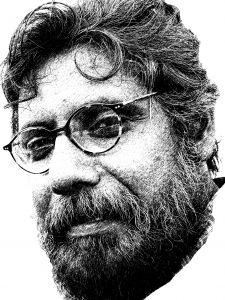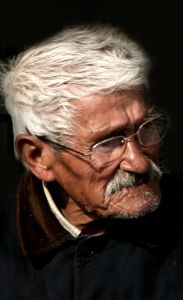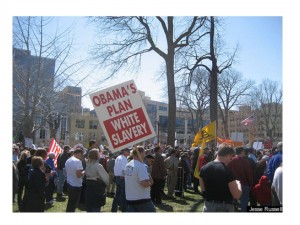– Hirsutism: The study of hair and its cultural implications. (see disclaimer below)
For the purpose of this article hirsutism is the sociological study of men’s facial hair. So, what does hair mean on a guy’s face? It says a lot more about the individual than many like to admit. Culturally, men’s facial hair often denotes wisdom, virility, and masculinity—and whatever that may entail. Just as women perhaps spend hours with their makeup, men spend just as much time worrying over their beards, mustaches, and goatees, all for the expressed purpose of portraying a certain image.
There was an Irish philosopher, George Berkeley, that postulated that the essence of being was nothing beyond what we were perceived as. Now, there are several fallacies within his postulation, but there is still a nugget of truth that probably resonates with more people than naught. For, while our existence is not predicated on how we our perceived, that doesn’t stop many from slaving over their appearance—including, most of all, facial hair. And here is a quick rundown of what facial hair styles says about a guy:
 Full-on Untrimmed Beard: Most men try to grow a full-on untrimmed beard at least once in their life, if for no other reason than as a symbol of visual maturity. But those who retain their full-on beard, well, they’re usually trying to hide something. Blemishes, asymmetrical face, pimples, it doesn’t really matter. While most men will say it’s because they look manly, it’s probably for a lot prissier reason.
Full-on Untrimmed Beard: Most men try to grow a full-on untrimmed beard at least once in their life, if for no other reason than as a symbol of visual maturity. But those who retain their full-on beard, well, they’re usually trying to hide something. Blemishes, asymmetrical face, pimples, it doesn’t really matter. While most men will say it’s because they look manly, it’s probably for a lot prissier reason.
Full-on Trimmed Beard: Those who have a full-on beard and trim it and take care of their beard are a different story. Usually the trimmed beard takes on dual roles: it both states that this particular hirsute individual is manly enough to grow a beard, but responsible and professional enough to be civilized about it.
Side-burn mustache: This is an illogical facial hair style. Side-burn mustaches make no sense because they are neither appealing in any sort of aesthetic way, nor do they effectively connote a sexually virile man. Instead, they’re more indicative of a purposefully insouciant personality—which of course is oxymoronic. An oxymoronic personality generally does things entirely because it wants to be perceived different from a crowd. But while it wants to be distinct from the crowd, it also, paradoxically, longs to be recognized by the very crowd it aesthetically rejects.
Side-burns: Beyond historical enthusiasts wanting to recapture Victorian-esque gentility, the side-burns signify nothing more than a man living in the past. Not a historical past, but rather the psychic past that each individual carries with them, and the side-burns are the visual manifestation of such.
Goatee and Van Dyke: The literati and academics use this as a hirsute style of prowess that visually connotes their ability to think, as if the brain could spring hair. But, like most of the other facial hair styles, its blatancy conveys something entirely different. It’s a façade, generally, for those within the academic circles as a fashion statement with no intellectual property. Those that aren’t literati and academics with a Van Dyke or goatee, well, they’re just trying to look smart and definitely can’t back it up.
The Nietzsche: It’s a gimmick mustache, and everyone knows it. It’s mostly used for philosophically comedic purposes. You can’t look at a man with The Nietzsche and not laugh.
Handlebar Mustache: The handlebar mustache is close to The Nietzsche in that it is a gimmick, but deviates in the fact that the handlebar is mostly used for ironic purposes, nowadays. Once a beacon for manliness within biker gangs and then epitomized by the Village People, its millennial purposes have once again transformed the handlebar mustache into a symbol for hipster-dom, those within a fringe ‘it’ group that’s sociological purpose is denoted by their largesse of money. Suburban frat-boys with a trust-fund and a lot of flannel shirts in their closet are you’re most likely culprits to wear the handlebar. Their virility, though, doesn’t translate so much from their facial hair as it does from their bank account, to which it’s not uncommon for those who do sport the handlebar mustache to have inadequate-sized dicks.
Straight-Up Stache: A simple mustache is the ultimate signifier for corporate businessmen with a need to portray their regality through the fibers of their hair. Its simplicity communicates to all who see that they are witnessing a professional do his work.
The Abraham Lincoln: This particular facial hair styles says, ‘Yeah, I’ve been shot, but I still made it into history books.’
The Dali: Let’s not go into the psycho-sexual denotations that are affected by a Dali.
Pedo-Stache: I don’t think I need to go into that.
The Hitler: Generally, the only people that will wear The Hitler are neo-Nazi, fascists, racists, white supremacists and separatists, and any low-life white trash trailer scum that still sports a swastika as if the war was still going on. It’s mainly used to get a rise out of those not within neo-Nazi gangs, and should be regarded with as much indifference as Germany should have regarded him 80 some odd years ago.
Clean Shave (i.e. No Facial Hair): I like to call it the Atheist style, though Atheists aren’t the only ones that sport the bare face, obviously. You can mostly find it around high schools and colleges for those unfortunate few that don’t have enough testosterone to grow facial hair, which can sometimes go into their mid-twenties. But for those that choose the bare face, it’s a strategic fashion statement that communicates the individuals discipline and diligence. Unlike other facial styles, the bare face necessitates constant and daily commitment to stave off five-o-clock shadow.
 Five-o-Clock Shadow: These are usually bachelors in wife-beaters who have an unwavering belief in patriarchal polygamy, and each morning suggests a post-coital mood on insouciance that they carry with them throughout the day—though people really know it’s their smugness in a thin disguise.
Five-o-Clock Shadow: These are usually bachelors in wife-beaters who have an unwavering belief in patriarchal polygamy, and each morning suggests a post-coital mood on insouciance that they carry with them throughout the day—though people really know it’s their smugness in a thin disguise.
Patches: Patches of hair on a man’s face is possibly one of the least attractive fashions that are mostly accidents, though at times are purposeful—in which case it’s more pathetic. Men with patches of facial hair usually are telling people with their facial hair how incapable they are of both not being able to grow an actual beard and of their laziness to shave and maintain their facial hair. It’s less of a style and more of an indication that they’ve given up.
There are of course many other facial hair styles, and if absolutely feel it necessary, you can list them out in the comments section. Some of them are for religious reasons, some are for psychological, and others just for the shit and giggles. Nonetheless, facial hair plays a crucial role in developing and sustaining man’s identity with regards to how they compose themselves within society. So think about, next time you’re looking at a man, and really think about what he’s communicating with how he cuts his hair on his face.
** Disclaimer: Just fyi and to clarify – this not really the definition of ‘hirsutism,’ and if you go to Wikipedia, or a real Encyclopedia — then you’ll find a different definition that has nothing to do with what I’m talking about. Thank you for entertaining us and our use of the word.
Hirsutism,




